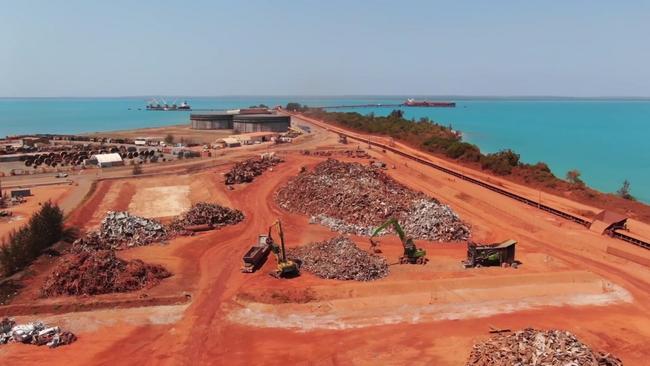How Rio Tinto’s exit will be worth millions to the Territory
Mining giant Rio Tinto has begun cleaning-up as it prepares to leave the Territory. See their history-making efforts.
Business
Don't miss out on the headlines from Business. Followed categories will be added to My News.
One of the world’s largest recycling projects is under way in the Northern Territory.
Global mining giant Rio Tinto is undertaking Australia’s largest ever demolition project at its Gove operations in East Arnhem Land.
Reclaimed metal from the multimillion-dollar project will be equivalent to three Sydney Harbour bridges or 21 Eiffel Towers.
Rio Tinto plans to leave Gove by the end of the decade, and the company has begun the clean-up by dismantling the old aluminium refinery, which was last used in 2014.
The first shipment containing about 15,000 tonnes of scrap steel was recently sent to Asia from Gove wharf for conversion into steel wire, bar and beam products.

In total 142,000 tonnes of steel in 10 shipments will be exported to Asia from the Gove refinery and about 300,000 tonnes of concrete will also be recycled from the plant for local road construction and other projects.
James Low, Rio’s general manager for closure at the Gove refinery, said the decision to demolish the refinery was taken in 2017 and is expected to be completed by 2027.
“This iconic site holds a lot of memories for the thousands of people who worked here over the last five decades,” Mr Low said.
“Even more significant is the immemorial connection that the Gumatj traditional owners have with the land. We are excited to be part of the work that returns the site to them.
“The Gumatj are integral to what we are doing at the refinery. They are the key decision-makers for how the site will be left in the future, including whether infrastructure like the wharves and warehouses will be handed over for ongoing use.”

Gumatj’s business arm is also supplying equipment for the demolition, which is being conducted by Liberty International.
Mr Low said as well as being a feat in Australia’s demolition pantheon, the project is also one of the largest anywhere in the world.
Liberty Industrial‘s Gove director Anthony Milanich said the project was going better than expected.
“We are very pleased with how this substantial project has been going, with the first of many scrap load outs successfully completed in better-than-expected time,” Mr Milanich said.
“We look forward to continuing our journey with Rio Tinto and traditional owners, who we consult and work with closely.
“This close collaboration has helped us find solutions to a number of challenges associated with a project of this size and complexity in a remote location.
“Liberty is committed to working with local subcontractors and traditional owners in a mutually beneficial way, including through work opportunities and demolition traineeships.”
The refinery demolition and remediation project is expected to be completed by 2027.
Bauxite mining at Gove is planned to continue until later this decade with rehabilitation of the broader Gove site expected to take until next decade.





